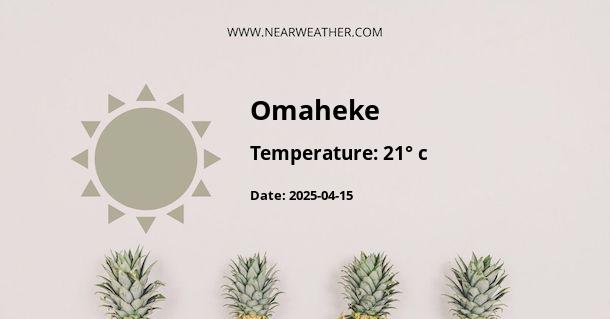Omaheke, Namibia: Climate and Weather Overview
Omaheke is a region located in eastern Namibia, known for its diverse and unique climate. The region is characterized by its vast savannahs, grasslands, and sparse vegetation. Omaheke experiences a semi-arid climate with distinct seasonal variations in temperature and precipitation. Understanding the weather patterns and climate in Omaheke is essential for residents, travelers, and anyone interested in exploring this captivating region.
Annual Climate Summary for Omaheke
The climate in Omaheke can be classified as arid to semi-arid, featuring hot summers and mild to warm winters. The region experiences low and erratic rainfall, with most of the precipitation occurring during the summer months. The following table provides an overview of the average monthly temperature and precipitation in Omaheke:
| Month | Average Temperature (°C) | Precipitation (mm) |
|---|---|---|
| January | 32°C | 65mm |
| February | 31°C | 71mm |
| March | 30°C | 52mm |
| April | 28°C | 26mm |
| May | 25°C | 7mm |
| June | 23°C | 1mm |
| July | 22°C | 0mm |
| August | 26°C | 0mm |
| September | 30°C | 2mm |
| October | 32°C | 11mm |
| November | 32°C | 21mm |
| December | 32°C | 35mm |
Source: Namibia Meteorological Service
Seasonal Variations
Omaheke experiences distinct seasonal variations, with the following characteristics:
- Summer (October to April): Summers in Omaheke are hot and dry, with temperatures often exceeding 30°C. This period also marks the rainy season, with the majority of the annual precipitation occurring during these months. Thunderstorms are not uncommon, and the landscape undergoes a transformation as vegetation blooms.
- Winter (May to September): Omaheke's winters are mild and relatively dry, with temperatures averaging around 25°C during the day. Nighttime temperatures can drop significantly, often reaching single digits. Clear skies and sunny days are typical during the winter months, making it an ideal time for outdoor activities.
Extreme Weather Events
While Omaheke's climate is generally stable, the region can occasionally experience extreme weather events such as droughts and dust storms. These events can have significant impacts on the local environment, agriculture, and livelihoods. Strategies for managing and adapting to extreme weather events are crucial for the resilience of Omaheke's communities.
Climate Change and Omaheke
Climate change poses a significant challenge for regions like Omaheke, where the delicate balance between precipitation and aridity is already finely poised. Changes in rainfall patterns, increasing temperatures, and the potential for more frequent and intense extreme weather events are all concerns for the region. Adapting to these changes and implementing sustainable practices will be essential for the long-term wellbeing of Omaheke and its inhabitants.
Conclusion
Omaheke's climate is defined by its arid to semi-arid characteristics, with distinct seasonal variations in temperature and precipitation. Understanding and adapting to the region's climate is crucial for sustainable living and development. As the impacts of climate change continue to unfold, proactive measures to address these challenges will be vital for the resilience and prosperity of Omaheke and its inhabitants.
A - Omaheke's Latitude is -21.750000 & Longitude is 19.416670.
A - Weather in Omaheke is 21° today.
A - Climate Conditions in Omaheke shows light rain today.
A - Humidity in Omaheke is 61% today.
A - Wind speed in Omaheke is 7.56 km/h, flowing at 259° wind direction. today.
